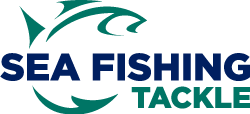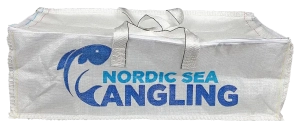Before the trip
Our goal is for everyone to have an unforgettable fishing experience on their trip with us. Planning your trip in advance usually pays off for a successful stay. On this page we have gathered information to help you prepare in the best possible way.
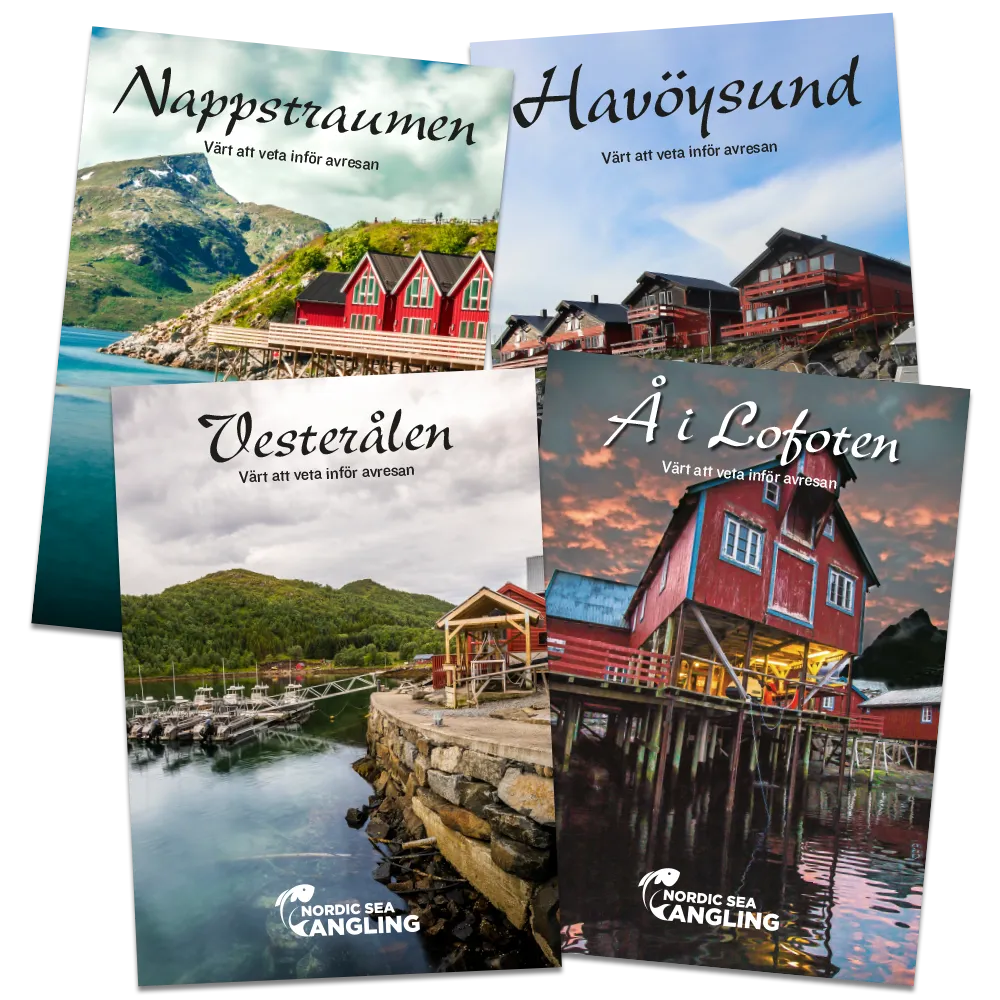
Prior to your trip, you will be sent an information brochure containing the necessary information about your destination. This will be sent out between 2-3 months before departure together with any airline tickets and schedules, depending on what you have booked. The same email also includes detailed charts for the area. There you will find detailed information on the following:
- Air travel
- Transfer
- Alcohol & Tobacco Quota
- Accommodation
- Check-in & Check-out
- Communication
- Purchasing
- Boats
- Weather conditions
- Clothing
- Equipment & Technology
- The fishery
- Fish species
- Waypoints
- Contact details of guides
- Address of the camp
Rules, Ethics and C&R
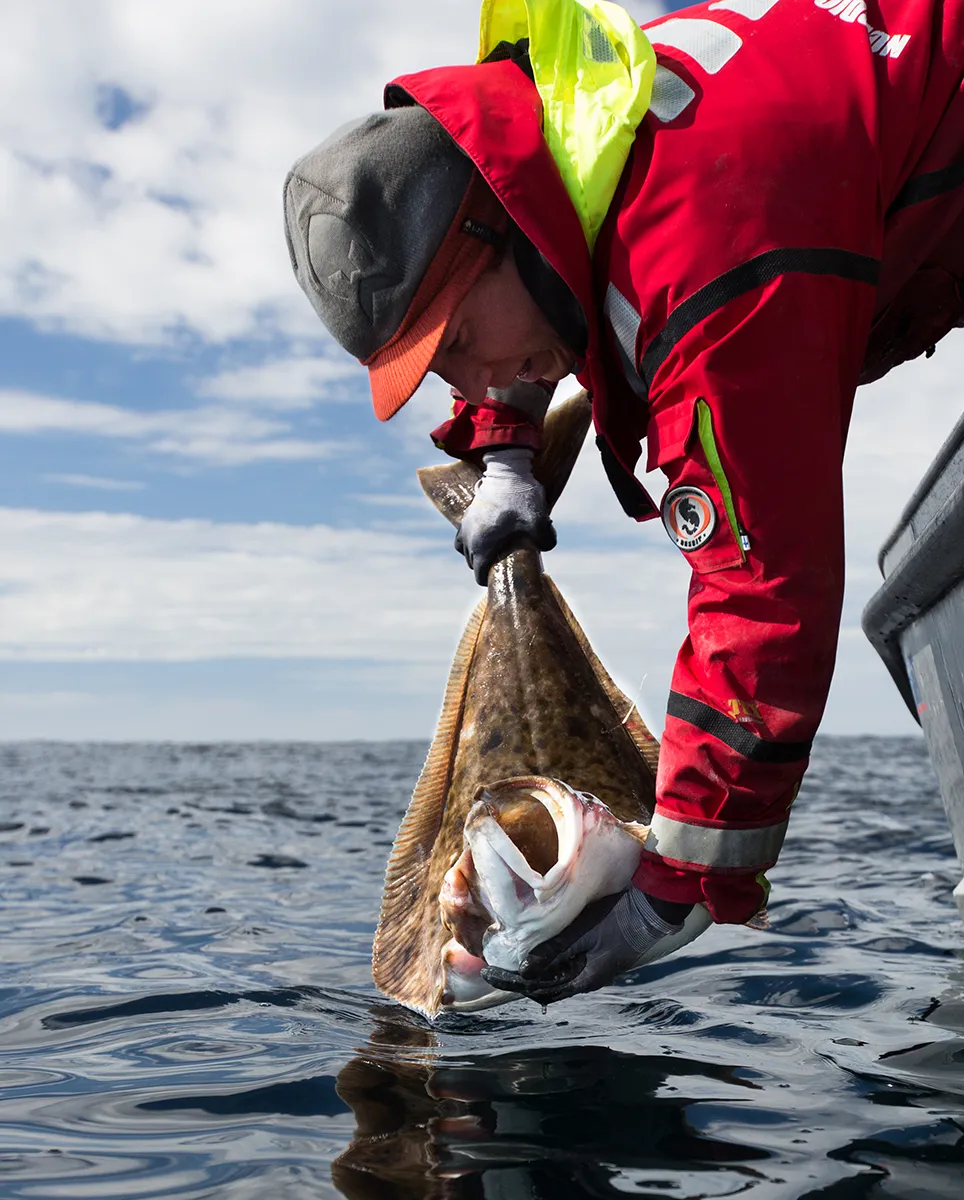 Feel free to take advantage of the opportunity to bring home top quality fish – but be mindful of the quantity. Nordic Sea Angling will not accept exceeding the Norwegian export quota of 18 kg of fish products. By fishing at a registered fishing camp, which we are, you are allowed to bring 18 kg of fish products per person, a maximum of two times per year.
Feel free to take advantage of the opportunity to bring home top quality fish – but be mindful of the quantity. Nordic Sea Angling will not accept exceeding the Norwegian export quota of 18 kg of fish products. By fishing at a registered fishing camp, which we are, you are allowed to bring 18 kg of fish products per person, a maximum of two times per year.
More information on this can be found here.
Significant overruns of the rules are not only a private bad thing. It also destroys our fundamental cooperation with the local population that we are keen to safeguard.
Don’t catch more fish than you (or others at the camp) can keep or that can be released. The guide will inform you on how to release fish, so that they do not suffer more than necessary and have the best chance of survival. In addition to handling, the type of fish, the depth of the water and the type of hooks used have a major impact on the survival of the fish.
On board the boats there are hook blocks, halibut hooks, tail ropes, rulers and weight/length tables, all to facilitate handling.
ATTENTION! It is forbidden to fish with livebait in Norway.
The halibut is a fantastically attractive fish for both sport and commercial fishermen. What’s more, halibut have always been surrounded by mystery, myth and respect – and not without reason. They grow very large and have a long life cycle. The large individuals are very important for the population, as they are females and carry important genes for the survival of the species. A Greenland halibut is not a culinary experience either, as they are often not very tasty.
We have chosen to set a recommendation to release all halibut over 130 cm, as long as the fish is not so severely injured that it will not survive the release. We also recommend that halibut over 130 cm should not be lifted into the boat but should be secured with the halibut hook on the outside. This is because large halibut are difficult to handle gently in the boat and can damage internal organs, bones and their protective mucus layer. By keeping the fish in the water, we can also avoid oxygen depletion. By following our recommendations, we believe that fishing for Greenland halibut will remain stable!
The minimum size for halibut is 84 cm (new rule from 1/6 2023) and even if you manage to hook a smaller halibut so badly that it will not survive, these must also be released back into the sea again as it is Norwegian law not to land a smaller fish than the minimum dimensions allow. We therefore recommend our guests to use halibut between 84-130 cm for the culinary experiences. Halibut over 200 cm must be discarded according to Norwegian law and may not be brought ashore.
Fishing for halibut is not allowed between 20/12 – 20/4 according to updated regulations.
When it comes to Catch & Release of cod, you should keep in mind that this species is more pressure sensitive as it has a swim bladder. This means that if the fish is reeled in too quickly from the depths, the swim bladder will expand so quickly that it is pushed out through the mouth. To avoid this, you should stop cranking as soon as you see the fish down in the water (about 10-15 meters below the boat) to let the swim bladder equalize adapt to the pressure. The fish will then release air and as long as it releases bubbles, you should try to keep it at that depth. As soon as it stops, you can crank up a couple of meters and then wait and see if it releases more bubbles . Do this in stages all the way up to the surface and you will be able to take nice pictures of your big cod and still be able to release it in a good way, unless you wish to keep it as food fish.
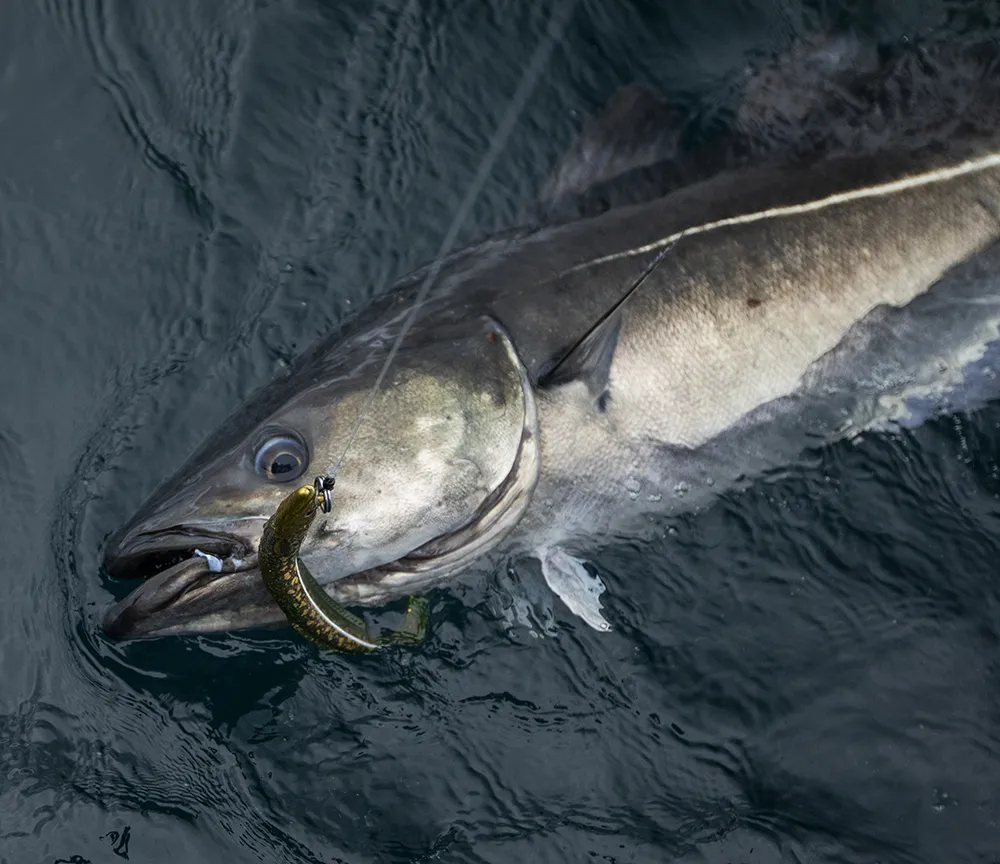 Coalfish (over 10 kg) is also very difficult to release but by following these guidelines, most fish can swim back again:
Coalfish (over 10 kg) is also very difficult to release but by following these guidelines, most fish can swim back again:
- Set the brake hard, based on what your equipment can handle
- Fight the fish hard to minimize fighting time and lactic acid in the fish
- Unhook the fish directly in the water
ATTENTION! Never lift a coalfish straight up with a classic grip by the gill cover. In the unlikely event that you want to lift it up, you must support it with your other hand at the belly and minimize the time that the coalfish is exposed to the air. Remember to stop fishing if you catch too many fish that do not survive. It is never justifiable to continue fishing if too many fish can’t be released.
Fishing for redfish is prohibited from 1 September to 31 May.
Make sure you are well prepared and learn how the equipment works, needed for hooking and landing your dream catch. Also, prepare your camera, measuring stick, gaffs and further on to speed up the handling process of the fish. If you have everything ready and are mentally prepared for how to land your dream fish, you will increase the chances of success when it strikes. During the information meeting at the camp, the guide will go through and show how to do a correct handling.
Catch registration
In Norway there is a Marine Resources Act, which is intended to ensure sustainable and socio-economically profitable management of wild marine resources and the associated genetic material. It is also intended to help secure employment and settlement in coastal communities. The Act states that the fish in the sea are a common resource that the Norwegian authorities must manage.
With this in mind, the Directorate of Fisheries in Norway has, as of January 1, 2018, made changes to the regulations surrounding the Norwegian Marine Resources Act. The most important change is that a tourist fishing establishment that meets certain criteria must register in the Directorate of Fisheries’ register, and report the establishment’s catch to the Directorate, in the same way as professional fishing is carried out.
In practice, this means that all tourist fishing destinations are obliged to register – and you as a fishing guest must register your catch daily during your stay. Your reported catch will become part of the total resource harvest in Norway. All registered tourist fishing facilities are obliged to have a system for reporting when you as a fishing guest arrive at the facility. The authorities see the new regulations as necessary to be able to offer a sustainable exploitation of nature’s resources. In other words, the authorities want future generations to experience fishing along the North Norwegian coast.
What do the new rules mean for you as a fishing visitor?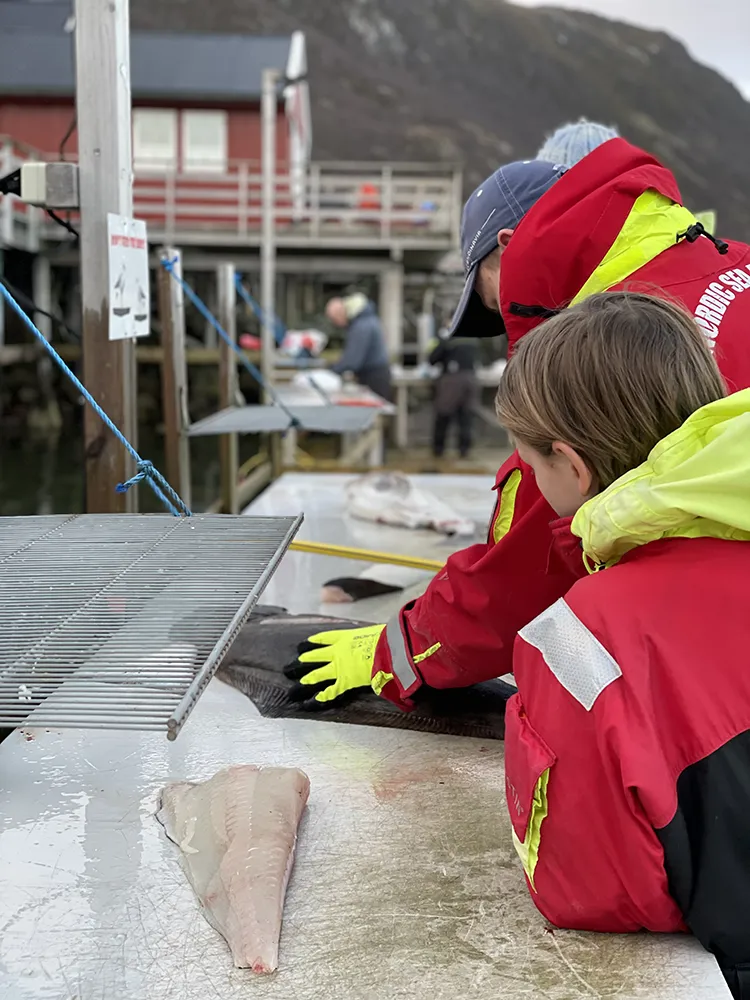
- Nordic Sea Angling is registered with the Directorate of Fisheries, which means that you as a fishing guest must register all catches of the following species: Cod, Halibut, Redfish, Catfish and Coalfish. It is the number of fish that counts, not its weight. You must record the number of fish landed and the number of fish released. You will receive all the necessary information and training on how to register on site by our staff on arrival.
- If you are a guest at a registered tourist fishing establishment, you can use the exit quota of 18 kg of fish per person. This is in comparison to fishing from an unregistered site where you are not allowed to take any fish home. In other words, it pays to be a fishing guest at a registered fishing facility, which we at Nordic Sea Angling are.
- We use an electronic system where you can register your catch via a computer, tablet or in your own mobile phone as long as you are connected to the internet. Upon arrival, you will be registered in the system by our staff and will be assigned a PIN code that is used to log in and register the catch under your name. At the end of the week, when the last day’s fishing has been registered, you will be checked out by our staff and given the necessary documentation.
- Upon departure, you as a fishing guest will receive a receipt/certificate that you have fished and registered your catch at a registered facility with the Directorate of Fisheries. This receipt/certificate gives you permission to take a fishing quota of 18 kg per person out of Norway. Without this receipt/certificate, you may not take fish out of the country
- Zero catch should also be recorded, i.e. a fishing trip where you did not catch any fish should also be recorded, but without a catch.
- There must be at least 7 calendar days between each time you as a fishing guest use the exit quota.
- You can only take fish out 2 times per calendar year.
More information on tourist fishing can be found at this link: https://www.fiskeridir.no/Turistfiske
Equipment
Fishing in Northern Norway requires fishing equipment, not only in the form of rods and reels, but also lines, hooks, split rings and other accessories. We have a well-equpped webshop (seafishingtackle.se) with Scandinavia’s largest selection for sea fishing where you can acquire and supplement your equipment before your trip.
All the products in the webshop have been carefully selected by us, and we can proudly recommend them based on our knowledge and experience.
We are happy to answer questions and provide advice on equipment, so do not hesitate to contact us if you are unsure of what to buy or need a recommendation.
To avoid excess weight and to supplement your equipment, you can also buy equipment on site, directly at the camp.
The range is not as wide as in the webshop, but there is a varied range and the price level corresponds to a regular fishing tackle store at home in Sweden.
Rental equipment
On site, you can rent your fishing equipment and floating suits. We use first-class equipment for rental to ensure a good fishing experience for your guests.
We use a mixed set of rental equipment, all to suit different fishing styles, fish species and different preferences of your guests.
Traditional sea fishing gear

We have carefully selected sea fishing reels that satisfy even the most demanding sea anglers. The reels are strong, light and solid. The gear ratio is relatively high, which is important in Nordic sea fishing to maintain control during fishing and to fight the fish effectively. The brakes can handle the fastest runs and toughest fishing conditions. These are among the absolute best sea fishing reels on the market. We offer both lever drag sea fishing reels and reels with star brakes and we have models in both right and left handed models. All reels are well filled with braided line in 0.36-0.41 mm.
Our rental rods are rated to 20-30 lbs and adapted for a varied fishing in Northern Norway. We use different models of boat rods from Westin’s W4 series. With a sturdy blank, high quality Japanese Fuji guides and a comfortable handle, these rods are designed for Nordic sea fishing.
We offer rental of this equipment on a weekly or daily basis for those who want to try it out. Fishing equipment (rod/reel/line) costs 600 NOK/person/week or 100 NOK/person/day
Spinning gear
We also offer heavy spinning gear for those who wish to cast for halibut, coalfish or cod with smaller jigs, pilkers, wobblers or poppers.
This equipment consists of heavy-duty 6500-8000 reel spools filled with 0.36 mm braided line. The rods are 7-8 ft long reel rods with casting weight up from 140-200 g.
We offer rental of this equipment on a weekly or daily basis for those who want to try it out.
Spinning equipment (rod/reel/line) costs 600 NOK/person/week or 100 NOK/person/day.
Lighter flat-fish gear
For those who want to try an exciting and fun fishing experience with lighter equipment, for smaller flatfish such as plaice, dab or why not haddock, we also have equipment for rent for this. We provide both lighter equipment with conventional reels and spinning reels. These can be rented for 400 NOK/person/week or 100 NOK/person/day. We need a pre-booking on this to guarantee availability.
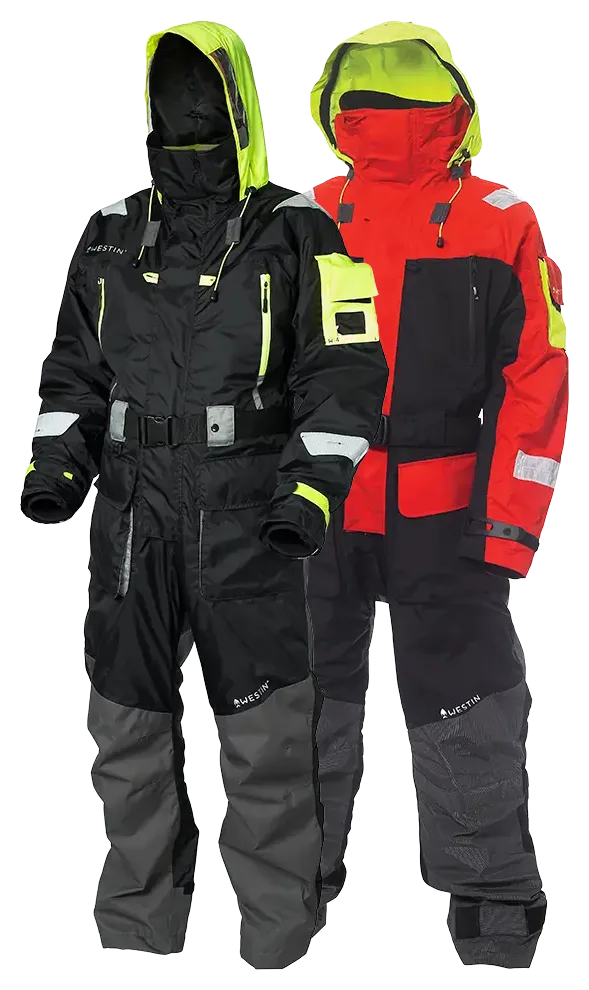
Floatation suits
The floatations suits that we rent out are of high quality. We have chosen Westins floating suits, which are some of the best floatations suits on the market. A floatations suits is good to have throughout the season because it can get cold quickly. If you freeze while fishing, you will fish less effective and it affects the whole experience negatively. A floatations suits also improves personal safety. The suit is washed between each rental. There are internal braces in the suit so that you can hang off the upper part if it gets warn, but have easy access so you can quickly put on the suit in case of an emergency.
The price for renting overalls is 450 NOK/person/week
If you wish to rent both fishing equipment and a flotation suit, you can do this at a package price of 950 NOK/person/week
All rental equipment should be pre-booked at least 1 month before departure to be guaranteed that rental equipment is available. Pre-bookings are prioritized and to be absolutely sure that your particular size is available, please indicate this when booking.
Rods & reels
A rod for sea fishing in Northern Norway should be in the 20-30 lbs class with a length of 5’5-7’6″. For those who intend to target large halibut, large cod or heavy deep-sea fishing, consider choosing a rod in the 30-50 lbs class instead. There are different opinions about rod lengths and this is often a matter of taste but a shorter rod can generally handle higher drag settings and will provide more lifting power in the blank.
A shorter rod is often easier to handle in the boat and to fish with and provides better power as the center of gravity comes closer to the body. A shorter rod, on the other hand, is less forgiving and requires more from you as an angler, to maintain pressure on the fish during the fight. Most experienced sea anglers prefer a slightly shorter rod when fishing for halibut and cod.
A longer rod has the advantage that the blank is more forgiving, maintains contact with the fish and you can keep the rod out from the edge of the hull, both while fishing, fighting or if you place your rod in the rod holder with a bait in the water. A longer rod is also generally softer at the tip, which signals bites clearly when fishing for ling, redfish, skate, etc. The longer rods are more all-round and suitable for more varied fishing.
You will find a wide range of sea fishing rods here.
The reel should have a smooth and powerful drag and enough capacity for at least 200-300 meters of braided line in dimension 0.36-0.41 mm. When fishing for redfish at large depths, it is recommended to have at least 400 meters of line on the reel as fishing often takes place over great depths. There are a abundance of different models on the market to choose from, most with lever drag, which is the dominant choice among sea anglers, but for those who wish there are also alternatives with star drag.
You will find a wide range of sea fishing reels here.
Always use a 100-150 cm long leader of 1.0-1.2 mm nylon/fluorocarbon to connect your lure. The easiest way to assemble the leader is to use a swivel at both ends and to attach the bait we recommend using a good quality split ring. Avoid snap-locks as these have a tendency to break or open themselves. The leader is there to protect the braided line from the rocky bottom and from the fish’s teeth.
Here you will find a large selection of braided lines and leaders.
Spin fishing
Spinning for halibut, coalfish and cod requires a powerful rod and a reel with a good brake. This fishing often offers tough fights and a smooth brake, even under heavy load, is a must. We recommend using a reel with at least 10 kg of braking power and a line capacity of at least 200 m of 0.30-0.36 mm braided line. There are many models to choose from which you can find here.
We have gathered all the necessary equipment for spin fishing in Northern Norway here.
It can also be useful to have lighter equipment for fishing for plaice. A lighter sea fishing rod, a vertical rod or a regular spinning rod can be used for this. Plaice fishing rarely uses weights of more than 100 g, and this does not place any great demands on the equipment used for the fights. A conventional reel or a spinning reel (depending on your preferences) with 0.20-0.25 mm braided line works perfectly well for this fishery. The same equipment can also be used when spinning for pollack around islands, skerries, peaks and kelp-covered bottoms.
Lures
Three different methods are generally used for sea fishing in northern Norway, as the number of species is high and fishing opportunities are varied.
Jig fishing
The first and perhaps most common are shads. These come in an abundance of different models and sizes but what they have in common is that they consist of a heavy lead/tin/zinc head with a rubber body and an integrated hook.
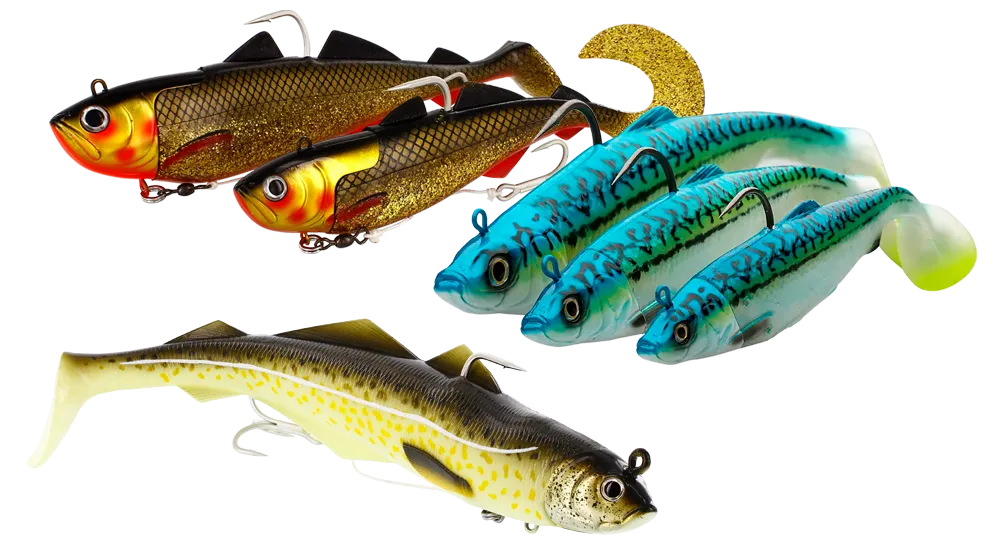 Shads are used for an active fishing style and require a drift on the boat, unless you are spin fishing with lighter shads. The shad has a natural action in the water but with the help of the rod and reel you can create an irregular movement pattern where the shad dives, rises, wiggles to the sides and acts like a wounded baitfish. This is what usually triggers the fish to bite and therefore makes jigging an active fishery. There are lots of different models and sizes to choose from. The most common is to use a shad between 200-400 g around 20-25 cm. This works for most species such as cod, coalfish, halibut, wolfish and ling. Larger shads (500-730 g) are most often used for skrei fishing where the cod periodically prefer really large baits and in addition, the large shads tend to selected out the largest individuals from the shoals. Smaller shads (100-200 g) can be used to advantage when fishing in shallow water or when spinning with heavier gear. The latter is particularly effective for halibut and coalfish and is an incredibly fun fishing method. The smallest shads between 30-60 g are mainly used for spinning for pollack but can also be used for fishing for smaller cod and coalfish too.
Shads are used for an active fishing style and require a drift on the boat, unless you are spin fishing with lighter shads. The shad has a natural action in the water but with the help of the rod and reel you can create an irregular movement pattern where the shad dives, rises, wiggles to the sides and acts like a wounded baitfish. This is what usually triggers the fish to bite and therefore makes jigging an active fishery. There are lots of different models and sizes to choose from. The most common is to use a shad between 200-400 g around 20-25 cm. This works for most species such as cod, coalfish, halibut, wolfish and ling. Larger shads (500-730 g) are most often used for skrei fishing where the cod periodically prefer really large baits and in addition, the large shads tend to selected out the largest individuals from the shoals. Smaller shads (100-200 g) can be used to advantage when fishing in shallow water or when spinning with heavier gear. The latter is particularly effective for halibut and coalfish and is an incredibly fun fishing method. The smallest shads between 30-60 g are mainly used for spinning for pollack but can also be used for fishing for smaller cod and coalfish too.
You will find a wide range of sea fishing shads here.
The vast majority of shads need to be rigged with a stinger hook attached to the back of the shad to secure the bites that only comes further back. Some models have this included while others require you to rig an extra hook yourself. We recommend tying your stingers with a soft kevlar material that is knotable and does not impede the movement of the bait. This needs to be durable as it often comes into contact with the fish’s teeth. If the fish is really on the bite, you can remove this stinger hook as it is usually enough with the original hook on the shad.
You will find both hooks and materials for making stingers here: Hooks – Lines
Pilker
The next category of baits are the classic pilker. Used mainly when fishing for cod and coalfish but will also regularly catch halibut, ling, wolfish and more. A lure that is easy to fish with, catches a lot of fish and can be used with advantage in heavy drift and rough conditions at sea.
The most commonly used pilker are between 200-500 g, but when fishing in really deep water, even heavier ones may be necessary. There are different models of pilkers, with varying characteristics. Classic spear pilkers sink quickly but have relatively little movement, while a curved pilker sinks more slowly but has more movement during fishing. You have to try this out, and decide which model is right for the moment, based on external circumstances.
You will find a wide range of pilkers here.
Baitfish rigs
Last but not least comes the baitfish method. A broad category that includes many techniques depending on the species being targeted. The most popular fishing method in Northern Norway today is undoubtedly the whole baitfish method, where a whole, dead fish is used as bait. This is a very effective method, not least for halibut, both large and small, but also works very well for large cod. The baitfish, which are most commonly smaller coalfish, mackerel or herring, are easily caught.
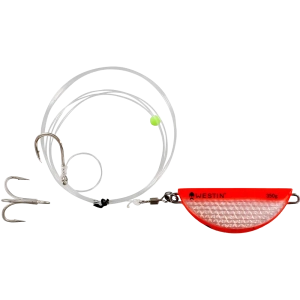 using a sabiki rigs with 3-5 small hooks with feathers, squid or flash material on it.
using a sabiki rigs with 3-5 small hooks with feathers, squid or flash material on it.
NB. Fishing with livebait is not allowed in Norway!
The easiest way to fish with baitfish is to use a banana-shaped sinker with a trailing leader. The advantage of a banana-shaped sinker is that they do not rotate in the water, thanks to its design and allows drift fishing over large areas, without getting tangled.
We recommend and use Halibut Anti Twist Rig in 350 g – 450 g.
You can use the rig included in the package, but we strongly recommend rigging your baitfish with a circle hook instead for several reasons.
- Better hookup ratio
- Losing less fish
- Safer landing of fish
- Gentler on fish
- Easier when doing catch & release
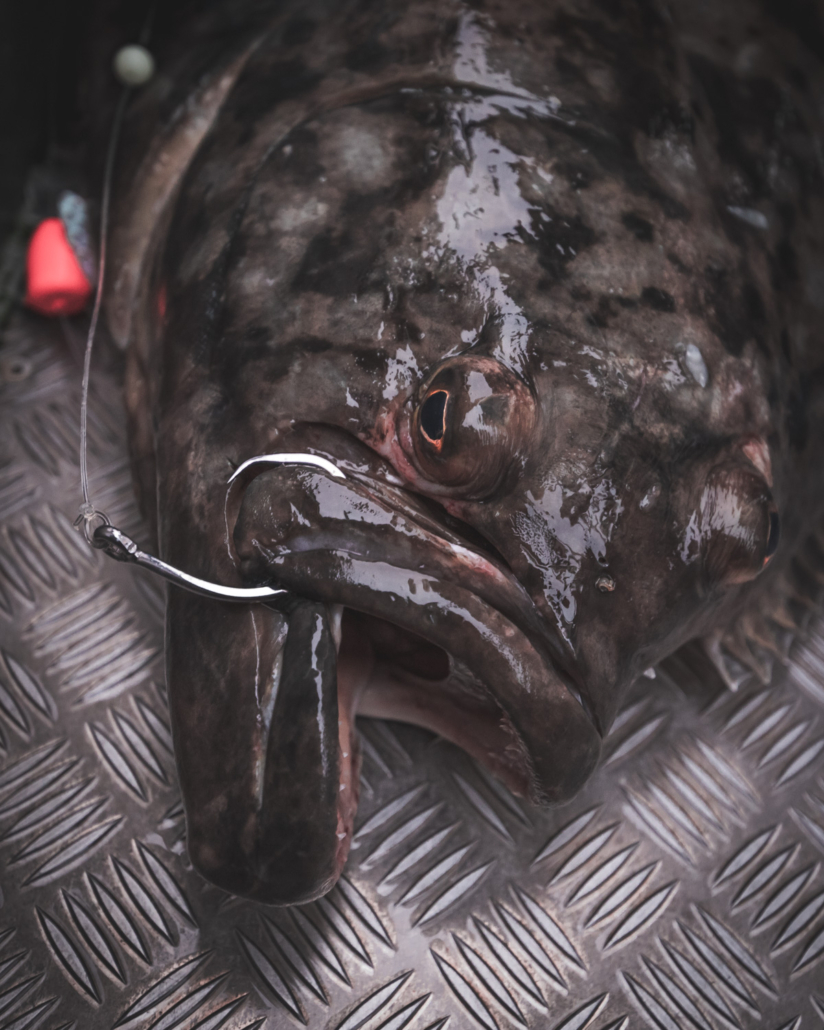 A circle hook has properties that allow it to attach itself to the corner of the mouth of the fish. This requires, however, that instead of making a hook-set with the rod, you tighten the line at a steady pace and let the hook twist into place at the angle of the jaw. If the fish has swallowed the bait and is swimming away, this will often happen naturally, otherwise you will have to crank the hook into place. This often requires a little more patience from you as an angler, but in return you lose less fish once it is hooked and is a much better from a Catch & Release point of view as the fish is not damaged by this. Even if the fish swallows the baitfish completely, the circle hook will first get a hold in the mouth, where it is securely anchored, thanks to its design.
A circle hook has properties that allow it to attach itself to the corner of the mouth of the fish. This requires, however, that instead of making a hook-set with the rod, you tighten the line at a steady pace and let the hook twist into place at the angle of the jaw. If the fish has swallowed the bait and is swimming away, this will often happen naturally, otherwise you will have to crank the hook into place. This often requires a little more patience from you as an angler, but in return you lose less fish once it is hooked and is a much better from a Catch & Release point of view as the fish is not damaged by this. Even if the fish swallows the baitfish completely, the circle hook will first get a hold in the mouth, where it is securely anchored, thanks to its design.
You can find a wide range of circle hooks here.
Other fishing styles with bait in northern Norway is usually done in deeper water for redfish, ling, tusk, skate, etc. For this we often use suspension tackle, such as a “paternoster-rig” with hook links where you attach small pieces of fish, fillets or a whole fish. We tie these ourselves by hand and sell them at the campsites up in northern Norway.
If you want to tie your own tackle, we recommend using luminous accessories such as squids, beads and light tubes that attract fish at depth. These tackle can be tied with both regular single hooks and circle hooks.
In shallower waters, bays and straits are teeming with life in the form of smaller flatfish. These are most easily targeted with tackle filled with beads, spinner blades, glow-in-the-dark rubber tubes baited with shrimp, artificial worms (with flavor and scent) or small pieces of fish.
We have collected tackle and lures for this in this category.
Clothing
Warm clothing is a must when traveling to Northern Norway, especially in spring or autumn. Temperatures can vary from summer heat to zero degrees in the same week. A flotation suit provides both safety and warmth. They are therefore very popular as fishing clothes. A fiber base layer or wool clothing is good to wear under the suits. Avoid cotton clothes, which absorb water and take a long time to dry. They are also heavy to carry in your luggage. Warm shoes or boots that are waterproof are also recommended in the boat. Don’t forget to pack warm socks, gloves and a hat for your trip too, aswell as sunglasses.
If you need to supplement with clothes for the trip, we have a large selection of both warm clothes, functional clothing, gloves and accessories here.
Packing list
Whatever your destination, it’s always good to have a packing list as a base for your trip. Here are our tips for packing your bag for fishing in one of our destinations.
Clothing
- Underwear
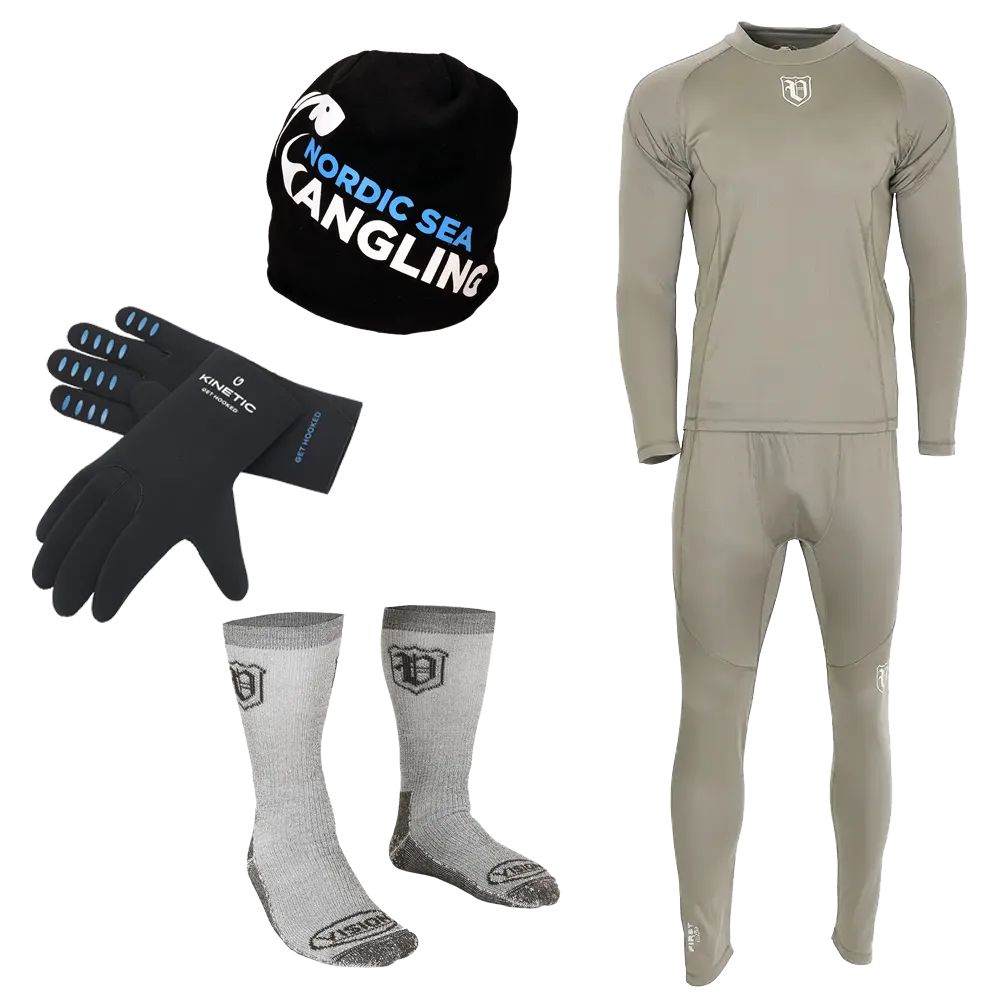 in wool or merino wool (wool has a warming ability even when wet)
in wool or merino wool (wool has a warming ability even when wet) - Trousers as intermediate layers
- Thicker sweater
- Buff or scarf
- Gloves for fishing
- Rubber gloves for cleaning fish
- Warming thick gloves
- Knitted hats
- Cap
- Thin wool socks
- Thick socks, e.g. ragged socks
- A pair of sturdy boots with lining or warm waterproof boots
Hygiene
- Tooth brush
- Tooth paste
- Deodorant
- Hand cream
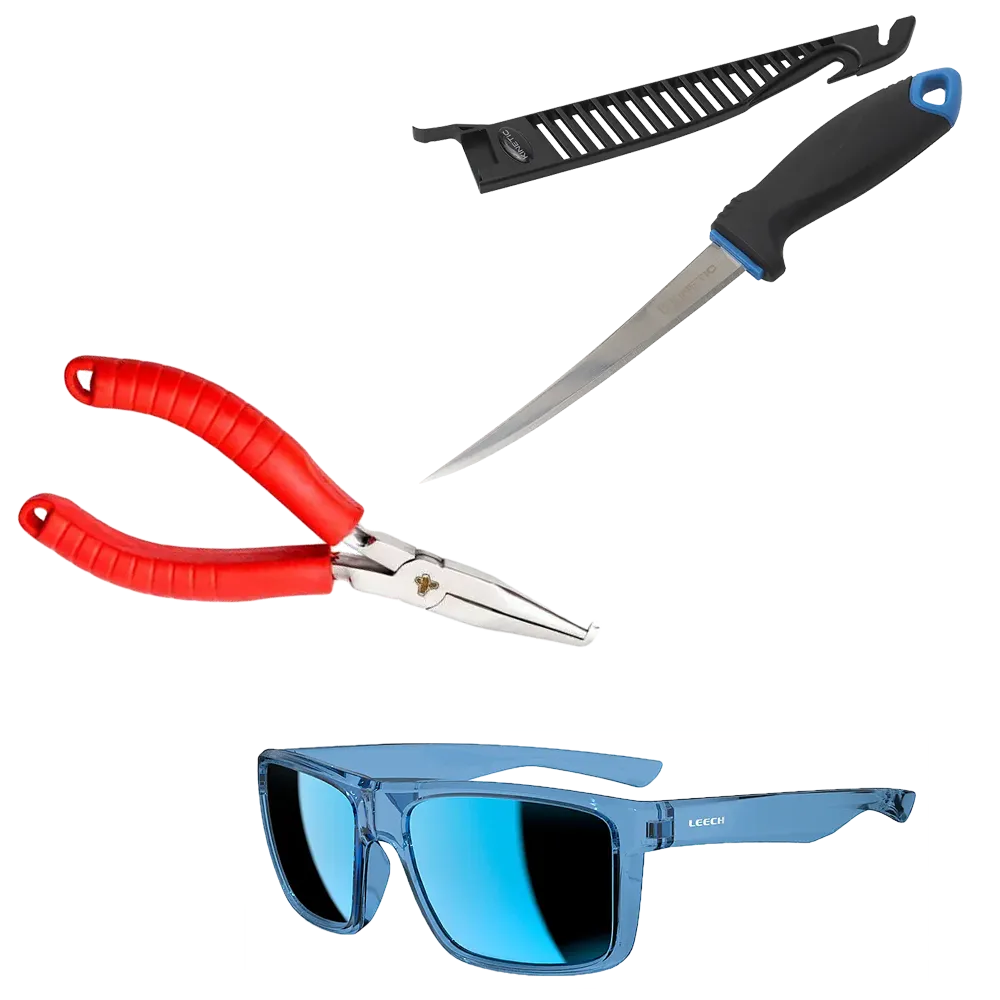 Disinfectant, alcogel or similar
Disinfectant, alcogel or similar- Adhesive patches
Other
- Superglue (For the shads)
- Camera
- Polarized glasses
- Ski goggles (especially in harsh conditions during spring/autumn)
- Heating bags
- Marking pen (for the fish)
- Duct tape for sealing styrofoam boxes
- Thermos (coffee/tea)
- Small towel to wipe your hands on board the boat
- Fillet knife
- Split ring plier
- Carrying case for fish box
Weather conditions
Here you can see current weather forecasts for your destination.

